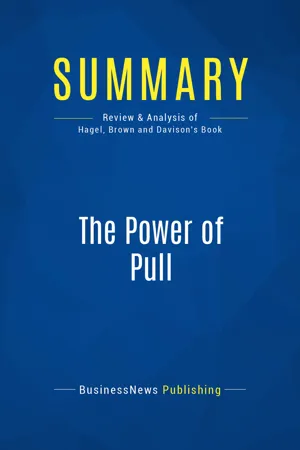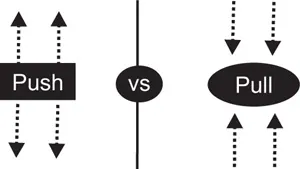
Summary: The Power of Pull
Review and Analysis of Hagel, Brown and Davison's Book
- English
- ePUB (mobile friendly)
- Available on iOS & Android
Summary: The Power of Pull
Review and Analysis of Hagel, Brown and Davison's Book
About This Book
The must-read summary of John Hagel III, John Seely Brown and Lang Davison's book: `The Power of Pull: How Small Moves, Smartly Made, Can Set Big Things in Motion`.
This complete summary of the ideas from John Hagel III, John Seely Brown and Lang Davison's book `The Power of Pull` shows that a profound change is underway in commerce and in society at large. In previous generations, elite planners created goods and services which were then offered to mass markets. Today’s consumers are now starting to cluster more and more around “pull” style platforms, i.e. technologies which allow products and services to be designed, produced and consumed on demand rather than according to a predetermined schedule. In their book, the authors explain how individuals who successfully learn how to harness pull will be able to access enormous resources to generate sizable improvements in performance.
Added-value of this summary:
• Save time
• Understand key concepts
• Expand your knowledge
To learn more, read `The Power of Pull` and discover the key to using `pull` style platforms to generate success.
Frequently asked questions
Information
Summary of The Power Of Pull (John Hagel Iii, John Seely Brown and Lang Davison)
1. What is Pull?

- Access – With Pull, you find the resources and the people you need as and when you need them.
- Attract – Pull has the ability to attract people who are just as passionate as you are about something.
- Achieve – Pull allows you to learn faster and therefore to perform better than would otherwise happen.
- Companies build up inventory and get it to distributors so product is available when customers demand it.
- Institutions like universities develop a curriculum based on knowing in advance what sort of education students need and breaking that down into modules and courses.
- Corporations attract and hire the talent they have projected they will need to deliver the desired customer experience, and then make certain they have all the equipment and resources required. They even have five-year plans which set out future demand with spreadsheet precision.
- Movie production companies, cable operators and the television networks spend billions of dollars every year creating programming they hope people will want to see next season or in the coming years.

- This shift is noteworthy because it is riding on the back of exponential advances in computer processing power which are ongoing. Even after forty years of development, the price/performance ratio of microprocessors continues to increase exponentially. When this is combined with the fact the price/performance of optical fiber and digital storage are also improving steadily, it is obvious the emerging digital infrastructure will completely reshape every institution imaginable during the twenty-first-century. The ongoing nature of these improvements also means that change is a constant and nobody has an opportunity to take a deep breath and play catch up.
- Advances in digital technology are reducing entry barriers to industry after industry around the globe. This means competition in every field is intensifying – which is leading to greater instability and uncertainty. Stock prices today are more volatile and consumers are much more fickle in their tastes. It’s harder than ever before to forecast demand with any degree of certainty.
- Tacit knowledge – the know-how of anything – is rapidly becomi...
Table of contents
- Title page
- Book Presentation
- Summary of The Power Of Pull (John Hagel III, John Seely Brown and Lang Davison)
- About the Summary Publisher
- Copyright